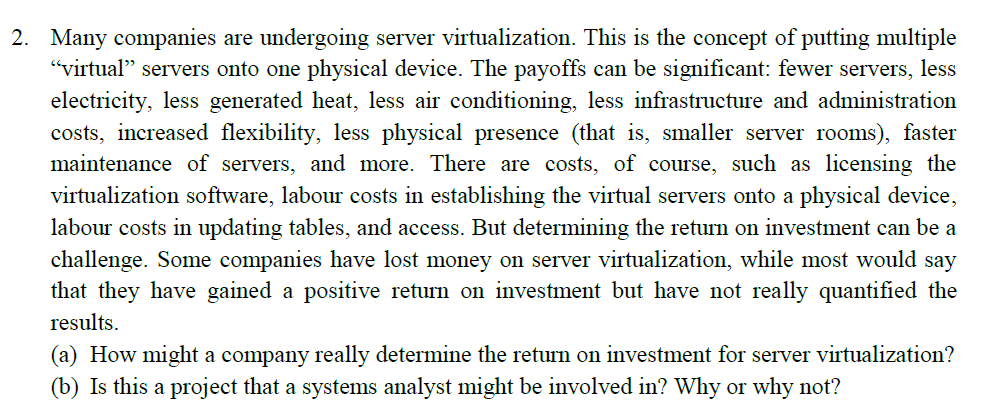Many companies are undergoing server virtualization. This is the concept of putting multiple "virtual" servers onto one physical device. The payoffs can be significant: fewer servers, less electricity, less generated heat, less air conditioning, less infrastructure and administration costs, increased flexibility, less physical presence (that is, smaller server rooms), faster maintenance of servers, and more. There are costs, of course, such as licensing the virtualization software, labour costs in establishing the virtual servers onto a physical device, labour costs in updating tables, and access. But determining the return on investment can be a
Many companies are undergoing server virtualization. This is the concept of putting multiple "virtual" servers onto one physical device. The payoffs can be significant: fewer servers, less electricity, less generated heat, less air conditioning, less infrastructure and administration costs, increased flexibility, less physical presence (that is, smaller server rooms), faster maintenance of servers, and more. There are costs, of course, such as licensing the virtualization software, labour costs in establishing the virtual servers onto a physical device, labour costs in updating tables, and access. But determining the return on investment can be a
Principles of Information Systems (MindTap Course List)
13th Edition
ISBN:9781305971776
Author:Ralph Stair, George Reynolds
Publisher:Ralph Stair, George Reynolds
Chapter3: Hardware And Mobile Devices
Section: Chapter Questions
Problem 15SAT
Related questions
Question
100%

Transcribed Image Text:2. Many companies are undergoing server virtualization. This is the concept of putting multiple
"virtual" servers onto one physical device. The payoffs can be significant: fewer servers, less
electricity, less generated heat, less air conditioning, less infrastructure and administration
costs, increased flexibility, less physical presence (that is, smaller server rooms), faster
maintenance of servers, and more. There are costs, of course, such as licensing the
virtualization software, labour costs in establishing the virtual servers onto a physical device,
labour costs in updating tables, and access. But determining the return on investment can be a
challenge. Some companies have lost money on server virtualization, while most would say
that they have gained a positive return on investment but have not really quantified the
results.
(a) How might a company really determine the return on investment for server virtualization?
(b) Is this a project that a systems analyst might be involved in? Why or why not?
Expert Solution
This question has been solved!
Explore an expertly crafted, step-by-step solution for a thorough understanding of key concepts.
Step by step
Solved in 2 steps

Knowledge Booster
Learn more about
Need a deep-dive on the concept behind this application? Look no further. Learn more about this topic, computer-science and related others by exploring similar questions and additional content below.Recommended textbooks for you

Principles of Information Systems (MindTap Course…
Computer Science
ISBN:
9781305971776
Author:
Ralph Stair, George Reynolds
Publisher:
Cengage Learning

Principles of Information Systems (MindTap Course…
Computer Science
ISBN:
9781305971776
Author:
Ralph Stair, George Reynolds
Publisher:
Cengage Learning